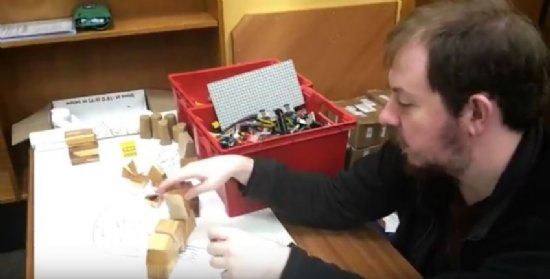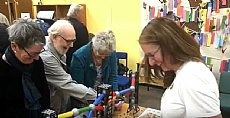Thomas Telford Workshop
Posted by Susan Kruse - 09:37 on 23 July 2018
 Our July Experimental Archaeology workshop was a very different affair from previous sessions. In previous workshops we either helped or watched an object being made, learning the craft and technology by observing and doing. But for Saturday’s workshop, looking at Thomas Telford and his work in the Highlands, we couldn’t build a replica Telford bridge, road, church, harbour or pier.
Our July Experimental Archaeology workshop was a very different affair from previous sessions. In previous workshops we either helped or watched an object being made, learning the craft and technology by observing and doing. But for Saturday’s workshop, looking at Thomas Telford and his work in the Highlands, we couldn’t build a replica Telford bridge, road, church, harbour or pier.
 Instead there was a lively session at Inverness Library. Susan Kruse from ARCH gave a background on Telford and his work in the Highlands. Alison Ward from the Institution of Civil Engineers came up from Glasgow as part of the ICE200 celebrations, and talked about Telford’s work and innovations. As she said, he was a superhero of the time, and his legacy is still felt.
Instead there was a lively session at Inverness Library. Susan Kruse from ARCH gave a background on Telford and his work in the Highlands. Alison Ward from the Institution of Civil Engineers came up from Glasgow as part of the ICE200 celebrations, and talked about Telford’s work and innovations. As she said, he was a superhero of the time, and his legacy is still felt. 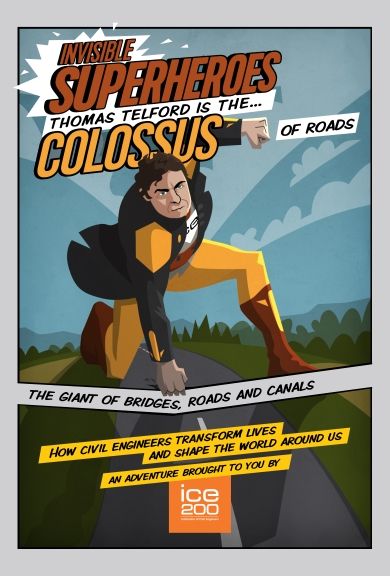
Telford had a profound effect on the Highlands, arguably one of the most influential people changing the face of the Highlands. In the 1790s working for the British Fisheries Society he upgraded and built harbours and piers – and recognised the need for good roads. In the first two decades of the 1800s for the Parliamentary Commissioners of Roads and Bridges he built over 1000 miles of roads, which needed hundreds of bridges and culverts. Piers were upgraded for ferries. By the end of this project the Highlands had a communications network – and it brought economic and social changes.
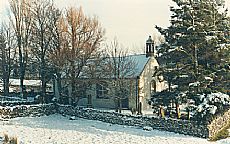
To understand much of what Telford did, the day had a number of experiments, models and resources to browse. Alison brought a kit allowing us to experiment building a cantilever bridge. This proved very popular! But it also brought home the message that for much of his work Telford had to experiment and improvise. There were other experiments on offer too using lego and building blocks. If we couldn’t build a Telford bridge, we at least grappled with the issues of foundations, stress and water flow.
 Holding this session in Inverness Library allowed us to use some of their fantastic resources. Telford was working on an autobiography but died in 1834 before it was completed. His colleague John Rickman edited and published it in two volumes in 1838. It has a captivating large atlas with plans, sections and drawings. Volume 1 is a mixture of offprints and extracts – more of a scrapbook in some ways than a traditional biography. One of my favourite parts is ‘Memorandum Book of Mr. Telford’, a section which has his notes on properties of different building materials, mathematical formulae for calculating stresses etc – his reference notebook compiled during a lifetime of work.
Holding this session in Inverness Library allowed us to use some of their fantastic resources. Telford was working on an autobiography but died in 1834 before it was completed. His colleague John Rickman edited and published it in two volumes in 1838. It has a captivating large atlas with plans, sections and drawings. Volume 1 is a mixture of offprints and extracts – more of a scrapbook in some ways than a traditional biography. One of my favourite parts is ‘Memorandum Book of Mr. Telford’, a section which has his notes on properties of different building materials, mathematical formulae for calculating stresses etc – his reference notebook compiled during a lifetime of work.
Inverness Library also holds the Reports of the Parliamentary Commissioners of Highland Roads and Bridges. Published initially every two years, and later yearly, they chart the progress of Telford’s work in the Highlands – and indeed beyond into the 1860s. These allow us to see how problems were encountered and dealt with. The 9th Report, written as Telford’s work was drawing to a close, is full of marvellous sections and plans (many reproduced in the Atlas) and a wonderful summary of his work.
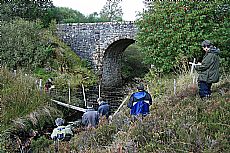 In the past ARCH has undertaken projects investigating Telford’s work in parts of the Highlands, notably Badenoch and Strathspey, southern Skye, and the Kyle of Sutherland. In the last area, we discovered an unrecorded Telford bridge just south of Lairg, and undertook a survey (results available in the Library of the ARCH website). John Fulton made a model of the bridge based on this survey. There was also a model made of peanuts and lentils showing how Telford built his roads in the Highlands – an innovative (and expensive) method designed to allow both carriages and cattle to use the network.
In the past ARCH has undertaken projects investigating Telford’s work in parts of the Highlands, notably Badenoch and Strathspey, southern Skye, and the Kyle of Sutherland. In the last area, we discovered an unrecorded Telford bridge just south of Lairg, and undertook a survey (results available in the Library of the ARCH website). John Fulton made a model of the bridge based on this survey. There was also a model made of peanuts and lentils showing how Telford built his roads in the Highlands – an innovative (and expensive) method designed to allow both carriages and cattle to use the network.
Altogether there was plenty to see and explore, and most people stayed for a couple of hours experimenting and reading.

Other Resources
On line Resources
Biography by Roland Paxon of ICE in Oxford Dictionary of National Biography, updated in 2013. This gives details about Telford and his works.
There are also a wealth of articles, pictures and other material about Telford on line – too many to list here! The Highland Historic Environment Record (HER) and Canmore both record information about Telford buildings, piers, harbours etc.
Books and articles
 Commissioners for Highland Roads and Bridges Reports. The full set is in Inverness Reference Library, while Reports 1-9 and 20 onwards are in Highland Archive Centre. This is an invaluable source detailing progress and developments through the years.
Commissioners for Highland Roads and Bridges Reports. The full set is in Inverness Reference Library, while Reports 1-9 and 20 onwards are in Highland Archive Centre. This is an invaluable source detailing progress and developments through the years.
Curtis, G.R. 1978-80. ‘Roads and bridges in the Scottish Highlands: the route between Dunkeld and Inverness’, Proceedings of the Society of Antiquaries of Scotland 110, 475-96. Although focussing further south, it still has a good summary of Telford’s activities and a typology of his bridges. Available Inverness Reference Library, Dingwall Library or on-line.
Haldane, A.R.B. 1962.New Ways through the Glens. The best overview of Telford’s activities. Available in some Highland Libraries.
MacLean, Allan 1989. Telford’s Highland Churches. Available in some Highland Libraries.
Paxton, Roland (ed.) 2007. Thomas Telford: 250 years of Inspiration. A very useful booklet published by ICE and available from their bookshop. Many of the articles are available on line.
Southey, Robert 1929. Journey of a Tour in Scotland in 1819. London: John Murray. Also available on the internet. Invaluable account of travels just after Telford had completed his works – but biased, because Southey was a close friend of Telford.
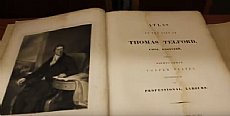 Telford, Thomas ed. John Rickman 1838. Life of Thomas Telford, Civil Engineer. Telford’s autobiography completed after his death by John Rickman. Contains large atlas with many drawings. Available Inverness Reference Library.
Telford, Thomas ed. John Rickman 1838. Life of Thomas Telford, Civil Engineer. Telford’s autobiography completed after his death by John Rickman. Contains large atlas with many drawings. Available Inverness Reference Library.
Archives
The Highland Archive Centre has a wealth of archive material on the Caledonian Canal, as well as some Telford plans and other materials. It also houses the local council roads committee minutes which often mention Telford and his work.
Other archives relating to Telford’s work are scattered throughout the country but include National Records of Scotland in Edinburgh, The National Archives at Kew and the Parliamentary Archives at Westminster.
The Experimental Archaeology: Learning about technologies in the past project has been funded by Historic Environment Scotland and the Heritage Lottery Fund.
This session was also supported by Institution of Civil Engineers.
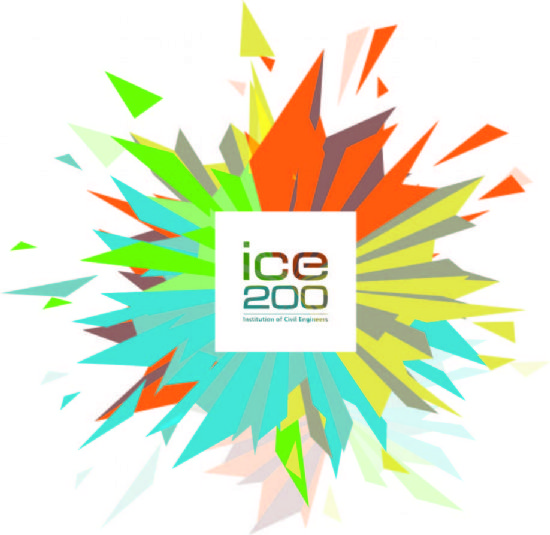
Add your comment below
- Recent Blog Articles
- Learning Resources
- Crafting Day October 2018
- Medieval Coinage Workshop
- Viking Ring-Money workshop
- Thomas Telford Workshop
- Monthly Blog Archive
- June 2018
- May 2018
- April 2018
- March 2018
- February 2018
- January 2018
- December 2017
- November 2017

